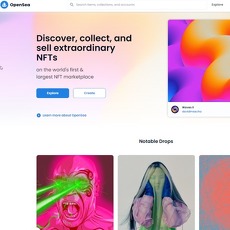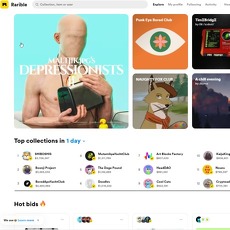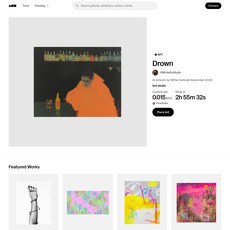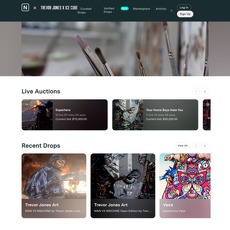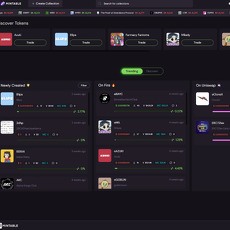SuperRare Review
SuperRare
superrare.com
SuperRare Review 2025: Is It the Right NFT Marketplace for You?
Have you ever felt overwhelmed by the sheer number of NFT marketplaces available right now? You're definitely not alone. When selling or buying digital art, the platform you choose can significantly affect your success, costs, and even your creative freedom.
In recent months, one NFT marketplace that's become impossible to ignore is SuperRare. With artists consistently reporting impressive sales figures and collectors raving about exclusive, rare pieces, there's a growing buzz around whether this marketplace truly lives up to the hype.
Why Choosing the Right NFT Platform Is So Important
Let's face it—NFT marketplaces aren't all created equal.
If you settle for the wrong platform, you might risk:
- Paying excessive transaction fees or hidden costs that eat away at your profits.
- Limiting your art's visibility and reach to potential buyers.
- Being constrained creatively due to rigid guidelines or exclusivity barriers.
Studies show that top artists and niche collectors strongly prefer marketplaces tailored to premium art like SuperRare. A recent CryptoArtPulse report highlighted that platforms focusing on exclusive single-edition pieces typically generate significantly greater value per NFT than those offering mass-produced editions.
Here's How This Review Will Help You
In this detailed guide, I'm going to clearly break down:
- Exactly how SuperRare stacks up against popular rivals like OpenSea and Rarible.
- The specific costs associated with minting, selling, and trading your NFTs on SuperRare.
- Insights into SuperRare's exclusive community-driven aspects and marketplace nature.
I’ll share real-life examples and clear-cut comparisons to help you easily identify if SuperRare is the platform that matches your creative goals, audience, and budget or if you're better off elsewhere.
Who Am I to Tell You This?
When you're evaluating something as crucial as which NFT platform to rely on, experience counts a lot. I spend every day combing through hundreds of crypto services, reviewing marketplaces, wallets, exchanges—you name it—in detail to help people navigate the crypto world.
For me personally, SuperRare regularly comes up because both artists and collectors frequently ask about it. I've seen both impressive success stories and complaints about fees, exclusivity, and ease of use. My job today is to provide clear evidence-based insights directly relevant to artists and collectors considering SuperRare.
If you've found yourself wondering things like: Is SuperRare worth the higher costs? What makes this marketplace genuinely stand out? Or would you be better off sticking to OpenSea or Rarible? You're definitely on the right page—and I'm ready to clearly answer these for you.
Ready to find out if SuperRare is your perfect NFT platform match? Let's start by answering the most essential question up next:
What exactly is SuperRare, and how does it compare to others in this crowded NFT landscape?
What Exactly Is SuperRare?
Ever stroll into an exclusive art gallery and sense that unique feeling—like you're experiencing something truly special? Well, that’s the vibe SuperRare brings to the booming online NFT space. Unlike most NFT marketplaces you're probably familiar with, SuperRare isn't all about mass-produced digital collectibles. Instead, it positions itself more like a sophisticated digital art gallery—hyper-focused on rare, exclusive, one-of-a-kind creations minted directly on the Ethereum blockchain.
What does this mean for you, as an artist or collector? Let's get clear on the basics:
How Does SuperRare Work?
Simply put, SuperRare is designed as a digital marketplace built entirely on Ethereum, facilitating the buying, selling, and authenticating of digital artwork as NFTs (Non-Fungible Tokens). But remember, not just any NFT marketplace—SuperRare specifically:
- Allows artists to mint and sell exclusive, single-edition digital artworks.
- Features a tightly curated collection, handpicked by experienced curators rather than allowing anyone to mint freely.
- Utilizes Ethereum smart contracts, providing provable and verifiable authenticity and rarity for collectors and artists alike.
You might wonder, is all this exclusivity really valuable? Well, consider this quote from John Maeda, a famous technologist and digital artist:
"Collecting digital artworks isn't just about the pixels on the screen; it’s also about exclusivity and authenticity. Provenance matters. True collectors crave uniqueness."
And that’s exactly where SuperRare shines brightest.
Why Is SuperRare "Unique"?
If you're comparing options like OpenSea, Nifty Gateway, or Rarible, here's the key thing setting SuperRare apart—it only allows single-edition digital pieces. That means once someone buys your artwork, they're the sole, exclusive owner of that NFT. No second copies, no other sales, no duplicates to cheapen your hard-won creation.
Contrast this with marketplaces that let creators launch multiple editions—sometimes dozens or even hundreds—of a digital piece. The trouble with multiple editions is that it can dilute both value and collector interest. Collectors serious about supporting artists and seeking value often crave that exclusivity, and studies on digital collectibles repeatedly demonstrate exclusivity's direct correlation with increased perceived value.
Here's a fact to chew on: Late last year, the digital artist XCOPY sold their unique single-edition NFT "All Time High in the City" for a staggering $6 million on SuperRare. Would XCOPY have fetched such a price with multiple editions floating about? Not likely.
Still, exclusivity brings higher expectations and potential pressure. For artists, this could mean fewer overall sales but potentially more premium valuation. For collectors, exclusivity means carefully picking your investments and truly believing in your selected artists’ long-term potential.
Curious about whether SuperRare’s uniqueness and exclusivity truly justify its fees? Keep reading, because next up, I'm breaking down exactly how those costs stack up against its key competitors. Ever wondered exactly how much extra you're paying—or saving—for exclusivity? Stick around to find the answer!
Understanding SuperRare’s Fees: Does Quality Come at a Higher Price?
Let's tackle one of the hottest questions I get asked about SuperRare right away: Are the higher fees justifiable, or are you simply paying more for being part of an exclusive club?
Minting Fees on SuperRare Explained
If you've already explored platforms like OpenSea or Rarible, you probably noticed that minting fees matter—a lot. On SuperRare, minting your digital artwork doesn't work like on most other marketplaces. Here, when your artwork sells, a 3% minting fee is automatically subtracted from the final selling price. Now, let's put this into context:
- SuperRare charges a 3% minting fee at the sale’s final price.
- OpenSea and Rarible, by comparison, charge slightly lower fees of 2.5% for similar services.
At first glance, you might think, "Does half a percent really matter?" Truthfully, if you're working with higher-value art pieces, yes, it absolutely can. Imagine selling a piece for 10 ETH—currently valued around $20,000. On SuperRare, your minting fee would be around $600 (3%), whereas on OpenSea or Rarible it'd be closer to $500 (2.5%)—that's a $100 difference on a single sale.
"Price is what you pay. Value is what you get." — Warren Buffett
This quote reminds us that costs should always be considered against potential benefits. Could the difference in the minting fee potentially balance out through SuperRare’s high-end buyers or elite artist exposure? Let's continue to see clearly if that's true.
Transaction Fees and Artist Royalties
Now, minting fees aren't the whole picture. There's also the crucial factor of transaction fees and artist commissions. When selling on SuperRare, as an artist, you receive an 85% payout—which means SuperRare takes a solid 15% commission from your earnings. Compared to other marketplaces, that might feel a bit steep:
- SuperRare: takes a hefty 15% commission, paying the artist just 85%.
- OpenSea: earns their revenue primarily from buyers, taking just 2.5% per sale.
- Rarible: similarly charges 2.5% fees per transaction.
It's easy to look at those numbers and wonder whether SuperRare's premium service justifies such heavy fees. Ask yourself—do you want a platform known for its exclusive, highly-curated art culture offering dedicated buyers willing to pay top dollar, or are you more interested in lower fees on a broad-ranging digital marketplace?
You might wonder: Is SuperRare worth the premium cost compared to marketplaces like OpenSea? Let's examine exactly that important question next, by looking carefully at the direct comparison between these two NFT powerhouses.
SuperRare vs OpenSea: Is SuperRare Worth the Extra Fees?
Let's cut straight to the chase—when you're choosing between SuperRare and OpenSea, one big factor keeps popping up: the fees.
If you're an artist looking to sell your NFTs or a collector searching for hidden gems, fees can massively influence your decision. But before we talk numbers, let's keep in mind this quote by legendary investor Warren Buffett, which also rings true in the NFT space:
"Price is what you pay, value is what you get."
Fees: How Much More Expensive Is SuperRare Really?
In a head-to-head fees comparison, SuperRare's transaction cost stands out significantly higher than OpenSea’s:
- SuperRare charges artists a commission of 15% per sale.
- OpenSea takes only a 2.5% commission on transactions, making it considerably cheaper.
The gap is pretty clear, isn't it? If you're just looking at the percentages alone, you'd probably rush straight to OpenSea and give SuperRare a pass. Yet, there's more to this story than fees alone.
Quality and Exclusivity Comparison
This is where things get interesting.
OpenSea is known as the "everybody’s marketplace"—a bustling NFT bazaar with millions of transactions happening every day. Anyone and everyone can list their NFTs easily. It's undeniably attractive for newcomers and artists who want the widest possible market without much barrier to entry.
But on the flip side, OpenSea’s crowded scene can sometimes drown out high-quality pieces. A recent report from Nonfungible.com noted that some collectors find it increasingly challenging to differentiate truly valuable art from mainstream content on open marketplaces like OpenSea.
SuperRare flips this whole model upside down. It carefully curates each artwork, creating an art gallery-like ambiance. Each piece you buy or mint becomes exclusive—only one single-edition copy. Built on Ethereum, it emphasizes scarcity, artistry, and value.
That exclusivity has attracted top-tier artists such as XCOPY, Mad Dog Jones, and Pak, whose limited, single-edition works regularly fetch astonishing sums. Take XCOPY’s "Right Click and Save As", which famously sold for over $7 million during the NFT boom in late 2021. Artists and serious collectors are not merely paying fees; they're investing in reputation, curated exclusivity, and prestige—intangibles that OpenSea can find hard to replicate.
So does paying higher fees for exclusivity and quality actually pay off in the long run? It might if you're an artist capable of commanding premium prices or a savvy collector looking for pieces from world-class artists. You aren’t just paying higher fees, you're buying into a highly selective community with a reputation for quality and authenticity.
But wait—fees and exclusivity aren’t the only factors at play when choosing your ideal NFT marketplace. What about a more artist-focused but still relaxed platform like Rarible? Let's take a closer look next, because your perfect match might still surprise you...
Comparing SuperRare and Rarible: Which One Fits Your Needs?
If you're caught up in the buzz around NFTs, you've likely run across both SuperRare and Rarible. But let's be real—you're probably asking the same question as everyone else: "Which one's right for me?" Let's take an honest, straightforward look at these two popular NFT platforms, and see which matches your vibe, your financial goals, and your creative style.
Platform Fees: How They Compare
One of the biggest considerations—admit it, it's usually the first thing you check—is how much each platform dips into your profits.
- SuperRare: When you sell artwork here, they're going to take a sizable chunk—15% commission off the bat goes directly to the artist from every sale. Additionally, minting costs 3%, slightly higher compared to many other marketplaces.
- Rarible: Rarible keeps things simpler and lighter on your wallet, with just a 2.5% commission charge per transaction, and another 2.5% for minting. That’s notably friendlier if you're budget-conscious or new to making NFT sales.
A quick practical scenario: Suppose you sell a digital artwork worth 1 ETH (roughly $2,000 at the current market value). On SuperRare:
- 15% (2000 x 0.15 = $300) goes to the artist as royalty each resale
- 3% (2000 x 0.03 = $60) fee to mint the NFT
That's right out of your pocket upfront. Meanwhile, on Rarible, that same sale would cost you just $50 upfront for minting (2.5%) and another $50 (2.5%) from the final transaction. That's a total of $100 against SuperRare’s combined $360 fee. Clearly, the cost difference adds up if you're creating or selling digital art frequently.
"Art is not what you see, but what you make others see." - Edgar Degas
Think closely about that quote. If the fees impact how—and where—you present your unique art, it’s crucial you pick the platform that aligns comfortably with both your budgets and your long-term artistic goals.
Creative Freedom and Marketplace Style
Beyond pure economics, let's get real—each platform has a personality. You need to pick the vibe that matches your creative energy, right?
- SuperRare’s Expertly Curated Environment: It's about exclusivity and art-world prestige. Here you’re not just minting any random doodle; SuperRare is picky, selective, and prides itself on high-quality, original digital art. If you're looking to position yourself amongst elite artists and collectors—think gallery vibes rather than casual flea-market crowds—this is your place.
- Rarible’s Community-driven, Casual Atmosphere: This platform is notably less exclusive but very welcoming and creator-friendly, ideal for new artists, collaborations, and niche collector communities. More freedom to experiment with lower stakes—and less pressure.
In short (and to keep it simple), choose SuperRare if art exclusivity and prestigious clientele align with your artistic goals; opt for Rarible for lower fees, freedom, and community flexibility.
But wait—fees and vibes aside, have you ever thought about exactly who benefits most from the higher-end exclusivity SuperRare offers, and if you'd truly fit that role? Let's answer precisely that next…
Who Benefits the Most From Using SuperRare?
You might've heard people chat enthusiastically—often passionately—about their stellar experiences or striking success they've found on SuperRare. But let's pause and really ask the essential question: Is SuperRare genuinely crafted just for you? Well, that depends entirely on the type of artist or collector you identify as—and what you hope to achieve in the vast NFT landscape.
Exclusive Artists and High-End Collectors Flourish at SuperRare
It's no secret that SuperRare leans heavily towards serious art advocates and seasoned NFT collectors craving exclusivity. For those artists with a remarkable, unique style ready to pull in high-value sales—I'm talking serious profit potential—SuperRare offers unmatched exposure. Collectors with deeper pockets and refined taste are naturally drawn here too, attracted to artworks that others simply can't get anywhere else.
Take, for example, celebrated digital artists such as XCOPY who've minted single-edition works on SuperRare, netting hundreds of ethereum per sale. Major collectors often gravitate to such unique pieces on SuperRare because owning a coveted, singular edition NFT adds both prestige and financial value to their portfolios.
"SuperRare is more than a market; it's a tightly curated gallery offering digital scarcity—exactly what high-end NFT collectors are hungry for."
But who exactly thrives best on this premium stage?
- Artists with a defined, exclusive collection they're confident will resonate strongly with premium collectors.
- Creators focused on long-term reputation-building rather than just quick flips or casual sales.
- Collectors specifically seeking scarcity, uniqueness, and art with emotional and aesthetic significance, rather than simply affordable NFTs.
And What if You're New or Budget-Conscious?
That's the real catch, isn't it? Because every shiny diamond inevitably casts its own distinct shadow.
If you're just getting your feet wet in the NFT community—without extensive funds reserved for minting fees—you might find SuperRare a challenging place to start your journey. Unlike marketplaces such as OpenSea or Rarible, known for easy onboarding and approachable minting costs, SuperRare's exclusivity and noticeably higher fees may discourage your initial ventures.
A recent study by Chainalysis even pointed out that beginners and traders on tighter budgets frequently opt for more accessible and open marketplaces to minimize risk as they learn the ropes. It's crucial, then, to consider your own risk tolerance and budget before confidently diving headfirst into SuperRare's curated niche market.
- Beginners: Typically fare better starting on OpenSea or Rarible, where process and fees are more beginner-friendly.
- Budget-focused artists: Often seek lower-cost platforms initially, enabling experimentation without major financial pressure.
- Casual NFT traders: Prefer frequent trading volumes or multiple-edition NFTs, benefits that SuperRare doesn't typically support.
I get it, deciding where to stake your claim as an artist or collector isn’t straightforward—you want the best return, and you certainly don't want regrets. Which brings me back to a critical point sweetening the question even further: Is SuperRare really good when you weigh in both benefits and downsides side-by-side?
Keep reading, because I'm about to address exactly that—with a clear, concise breakdown of SuperRare's Pros and Cons that every NFT enthusiast and creator needs to consider before making their decision.
Pros and Cons Summary: Is SuperRare Actually Good?
As someone who deeply cares about helping you make smart NFT decisions, let's do a quick reality check and weigh the pros and cons of SuperRare clearly. Nothing sugar-coated—just straight talk about exactly what you'd gain or lose by choosing this platform.
Pros at a Glance
- Exclusivity and Limited Editions: SuperRare strictly offers single-edition pieces. You're never getting a copy that's plastered all over social media; your art truly remains one-of-a-kind. This exclusivity boosts both uniqueness and long-term value.
- High-End Reputation in NFT Art Market: When artists like XCOPY and Hackatao choose SuperRare, that signals serious credibility. Collectors spend big money here precisely because it's respected and trusted.
- Strong Curator Community: This isn't generic digital clutter—expert-led curation means you'll find genuinely valuable NFTs that appeal to collectors who mean business.
One NFT collector friend put it neatly:
"To buy art on SuperRare isn't about flipping assets—it's about owning digital masterpieces you can proudly display."
Hold onto that feeling, because now let's quickly face the facts on the downside too.
Cons at a Glance
- Higher Minting and Transaction Fees: When comparing minting fees, SuperRare charges around 3%, slightly higher than Rarible or OpenSea at 2.5%. Even heavier is the artist commission (up to 15%), which can bite off a chunk of your profit margins—something casual sellers definitely won't love.
- Less Ideal for Casual Sellers or Budget-Conscious Artists: If you're just dipping your toes into NFTs or don't have a big crypto budget, higher minting fees and exclusivity of SuperRare can feel prohibitive.
- Fewer Features Compared to Mass-Market NFT Marketplaces: SuperRare is refined, curated, and minimalist compared to bustling marketplaces like OpenSea. Forget interactive trading tools or elaborate features; SuperRare keeps it lean and simple—good for art purists, but maybe boring for others.
Before making your final choice, remember this: the decision between SuperRare and platforms like OpenSea or Rarible boils down to balancing exclusivity versus affordability.
What really fits your NFT style? If you're still uncertain, don't worry—I have some extra, helpful resources coming next that many NFT artists and traders swear by.
Curious what those are? Let's keep moving...
Additional Helpful Resources for NFT Traders
If you're anything like me, keeping up with NFTs and crypto can sometimes feel like a full-time job all by itself. There’s always something new happening, with platforms evolving and the market shifting constantly. Thankfully, there are some incredibly useful resources I always rely on to stay informed, make smarter decisions, and keep my crypto game sharp. Let me introduce you to a few of my favorites.
Recommended Crypto and NFT Resources You Can Trust
Let’s face it—quality research can make or break your NFT strategy. Personally, I regularly use platforms like CryptoSlam to quickly fact-check market prices and understand real-time NFT sales data. This tool gives you a crystal-clear view of current market trends, historical price comparison, and detailed analytics across virtually every NFT marketplace, SuperRare included.
Another invaluable site I check practically daily is DappRadar. It shows the most popular decentralized apps, ranking platforms based on user activity, transactions, and trading volume. Want to see if SuperRare activity is booming or dipping this month? DappRadar’s got you covered.
And let's not forget about Etherscan, crucial whenever you want to track transactions or wallet activities transparently. Wondering if that buyer who placed a bid on your NFT is legitimate? With Etherscan, you get a full breakdown of wallets and transaction histories, providing more transparency and peace of mind—exactly what we NFT traders love.
When it comes to education and keeping updated, Binance Academy is hands-down a trustworthy resource for understanding complex crypto concepts. They break down intimidating jargon into simple explanations for beginners and experts alike. Whatever your crypto question, chances are you'll find the answer right there.
For latest news and deep insights, Cointelegraph and CoinDesk stay at the top of my browser’s bookmarks. They consistently deliver reliable crypto news, NFT coverage, and sharp industry analysis daily. Staying informed has never been simpler—or more crucial.
If you're searching for super-actionable investment advice and NFT strategies, some of the most successful crypto traders I know regularly share thoughts and alpha leaks via Twitter and Discord communities. Some groups, like the Bored Ape Yacht Club Discord community or Twitter feeds of well-known NFT influencers, consistently produce useful content—and a little networking never hurts your chances.
The bottom line? To thrive in NFTs or crypto, using reliable resources is an absolute must. These trusted platforms help simplify your research, cut down your guesswork, and offer reassurance you're following informed strategies rather than hype alone.
Now, you might be wondering: What's next? How about we tackle some of your burning SuperRare questions directly—curious what those might be? Keep reading to find out!
Your SuperRare Questions Answered — FAQ
I've noticed there are some common questions readers consistently ask about SuperRare, so let's clear things up right now. I'll give you short, straightforward answers, backed by real examples and data from the NFT community—saving you hours of researching through forums or Discord chats.
Is SuperRare better than OpenSea?
To be completely honest, calling one platform "better" is not straightforward—it really depends on what you're after. SuperRare certainly has exclusivity and prestigious status, featuring single-edition NFTs and high-quality, curated art pieces. For instance, Beeple's "Crossroad" sold for $6.6 million on SuperRare precisely because of this reputation for exceptional art.
On the other hand, OpenSea caters more to the mass market, with significantly cheaper fees (just 2.5% versus SuperRare’s artist commission of 15%). Here’s how I'd put it:
- If you’re a collector looking for prestigious, rare pieces of art—SuperRare is undoubtedly the go-to marketplace.
- For beginners, casual collectors, or budget-conscious creators, OpenSea might be your better choice due to lower fees and less intimidating atmosphere.
Ultimately, ask yourself clearly what you want to achieve and what your budget is—then deciding becomes pretty straightforward.
How much does it cost to mint on SuperRare?
SuperRare charges a 3% minting fee on the final sale price, slightly above what platforms like OpenSea and Rarible charge (both typically at 2.5%). Let’s use a real example:
- Say your NFT sells for 2 ETH (approximately $6,000 at today’s market price), you'd pay SuperRare around 0.06 ETH ($180) as the minting fee.
- In comparison, on OpenSea, minting that same NFT would only cost you 0.05 ETH ($150). A small difference in this example—but when dealing with higher-value art, costs can quickly add up.
You’ll need to factor these differences into your pricing strategy and overall budget.
How does SuperRare work exactly?
This is a common (and important) question. In simple terms:
- SuperRare is built entirely on Ethereum blockchain technology, using ETH cryptocurrency exclusively.
- Each artwork on SuperRare is single-edition only. Basically, you won't see multiple versions or copies of art pieces—each NFT is truly one-of-a-kind.
- You create an artwork, mint it on Ethereum via SuperRare, and sell it directly through either an auction or fixed-price sale.
This exclusivity has led to many headline-grabbing sales like XCOPY’s "Right-click and Save As guy," selling for around 1,600 ETH ($7 million at the time).
It’s worth noting: this exclusivity attracts premium prices but also means it's a more competitive space than platforms like OpenSea that allow multiple-edition NFTs.
What’s the difference between Rarible and SuperRare?
These two platforms have distinctly different vibes and target users:
- Rarible: Offers lower fees (just 2.5%), more casual collectors, a larger community, and a marketplace with multi-edition NFTs. It feels more open and approachable, ideal if you like variety and lower prices.
- SuperRare: Charges higher fees (15% artist commission), but boasts curated art, exclusive single-edition NFTs, and a reputation that appeals to niche, high-end collectors.
An example might help make this clearer: A digital creator showcasing collectible avatars with hundreds of editions might find Rarible's casual vibe perfect—while a fine-art digital artist aiming for exclusivity and prestige likely finds SuperRare ideal.
Final Thoughts: Should You Use SuperRare?
Here’s the truth: if you're an established artist aiming for elite credibility or a passionate collector hunting for rare, unique digital masterpieces, SuperRare could absolutely be your favorite new NFT marketplace. It’s like shopping for art in a selective gallery rather than browsing an open flea market—more expensive but potentially more rewarding.
On the other hand, total beginners or cost-conscious creators might feel overwhelmed by SuperRare’s fees and highly curated selection. Platforms like OpenSea or Rarible might serve you better in this scenario—less costly, less exclusive, and easier entry-level environments.
Ultimately, the best marketplace matches your individual style, your goals, and your wallet. Right now, you know exactly what makes SuperRare unique and whether or not it aligns perfectly with what you're after. Ready to showcase some amazing art or add incredible digital pieces to your collection? Go decide—I've got your back either way.


